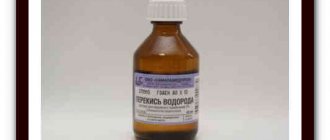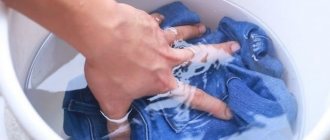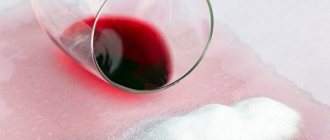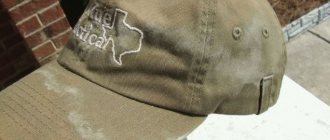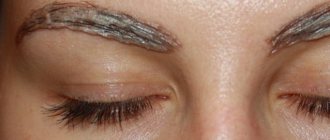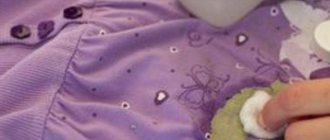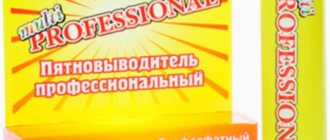Features of washing tulle
The success of the event depends on how correctly the detergents and washing regime were selected. This takes into account the nature and intensity of pollution. Curtains that decorate kitchen windows suffer not only from exposure to sunlight and dust. Because “kitchen fumes”, soot and even particles of fat, which float in the air in the form of fine particles, settle on their surface. First of all, the type of material is taken into account. Because a certain washing mode is recommended for each fabric.
| Material | Peculiarities | Temperature |
| Organza | Products made from this material are best washed by hand. If the machine is automatic, then only in the delicate wash mode. It is advisable to replace the powder with a liquid product. | No more than 30 degrees |
| Polyester | Can be washed in a normal (everyday) cycle. | 40-600 C |
| Veil | Delicate fabric that requires appropriate treatment (similar to organza). | 30-400 C |
| Capron | Washing can be done as usual, but without using active bleaches. | 600 C |
| Kiseya | The material is sensitive to mechanical and thermal effects. | 300 C |
| Materials based on natural fibers (cotton, linen, etc.) | Normal wash cycle. | 600 C |
| Other synthetic fabrics | Manufacturer's recommendations must be followed. | 400 C |
Washing rules
The water temperature and washing method (hand, machine) depend on the structure and composition of the fabric fibers. Tulle curtains are made from different materials:
- mixed fabrics;
- polyester;
- cotton;
- nylon;
- organza;
- veils;
- chiffon;
- muslin.
Mode
On the machine, the machine selects a delicate wash program (“Wool”, “Silk”, “Hand Wash”) with a maximum temperature of 30 °C. The spin function is not used.
Temperature
Factory-made curtains have a tag indicating the recommended water temperature. It’s more difficult with products sewn in a workshop or with your own hands. You need to visually determine the type of material and select the desired water temperature.
| Material | Temperature (°C) |
| Cotton | 40-60 |
| Polyester | |
| Blended fabric | |
| Capron | 30 |
| Veil | |
| Organza | |
| Kiseya | |
| Chiffon |
Using bleach
Products made of nylon and polyester are restored to their whiteness not with bleach, but with improvised means:
- blue;
- saline solution;
- ammonia;
- brilliant green.
For curtains made from other materials, bleaching agents containing hydrogen peroxide are suitable:
- "Sail";
- Vanish;
- "Persol";
- Belle;
- "Velvet".
The snow-white color of the fabric is restored with the preparations “Ace”, “Bos Plus”, Beckmann. They contain fluorescent substances. They reflect light off the surface, making the tulle appear whiter.
How often do you need to wash?
According to doctors, tulle should be washed every 2-3 months. Dust settles on the airy part of the interior, mites and other harmful microorganisms grow in it, causing allergies.
Kitchen curtains get dirty more often than others; they are advised to be washed once a month.
How to wash without needing to iron
Curtains are not twisted to prevent wrinkles from appearing on thin fabric. After rinsing, the fabric is taken out of the water and hung over the bathtub (basin). Shake the tulle well, when the water has drained, hang it straightened on hooks.
Machine wash: nuances
The process largely depends on the model of the washing machine. If it is a little outdated, this does not mean that it will not be possible to wash tulle in it. You just need to select the “hand wash” mode and the optimal temperature. More modern models have expanded functionality, which allows the housewife to select the mode as accurately as possible. For example: “delicate wash”, “wool”, “silk”, “curtains”.
There are general rules for machine washing:
- If there is severe contamination, it is recommended to prepare a saline solution (2 tablespoons of salt per 5-7 liters of cold water) and place tulle curtains in it for several hours, or better yet, overnight.
- Regardless of the presence of hooks and decorative elements, it is recommended to wash tulle in a special bag or cover. This will ensure that the fabric will not be damaged. If for some reason the protective cover is not used, then placing the tulle curtains into the drum must be done extremely carefully. There should be no folds!
- Spinning is not carried out at all, or at low speeds (no more than 500).
- Maintaining temperature conditions is a must!
- For machine washing, it is better to use a gel product rather than powder. However, it needs to be added in small quantities (about half the usual volume).
- After machine washing, the additional rinse mode must be turned on, since tulle “does not like” when detergent remains in it. He will definitely react to this with ugly streaks.
Machine wash is not permitted for all types of tulle. Organza and natural silk are the most vulnerable materials!
Which mode to choose for machine washing
If tulle is used as curtains, due to its large size, it is difficult to clean them by hand. It is logical to wash it in a machine. Modern machines provide the functions “Hand Wash”, “Delicate Wash”, “Curtains”, “Silk”. The number of revolutions and degrees are adjusted automatically. Some recommend the “Wool” program, which allows you to wash the curtain without distorting it. If such programs are not available, follow these rules.
- temperature does not exceed 40°C, pure cotton – 60°C;
- number of revolutions up to 400;
- always soak the fabric before washing;
- fold the fabric without crumpling;
- put thin fabrics in a special bag;
- The “Spin” program cannot be used;
- If desired, select the “Extra rinse” program.
After setting the mode, select the necessary detergent.
Traditional powder is suitable for inexpensive nylon, polyester and cotton tulle and curtains. For cotton, bleaching powders or detergents for washing children's clothes are used. They are delicate, hypoallergenic, and effectively fight dirt. There are special bleaching agents for synthetic fabrics; read the instructions before using them. For colored products, powders are used in accordance with the color of the fabric.
- Features of bleaching tulle from yellowness
- Advantages and disadvantages of washing a wedding dress at home
- How to wash soft toys by hand and in the washing machine
For another type of tulle, delicate wash shampoos are used. They carefully clean fabric, remove stains, and rinse quickly. This is necessary for fabrics subject to deformation: silk, organza, veil, muslin. They are placed in a laundry bag to prevent wrinkles from forming.
Don't overdo it with the amount of detergent. They are put in a little. Foaming is good even in small quantities; during the rinsing process, a small amount of detergent will go away faster. We do not use the spin function. Shake well and hang to dry. Ironing is not recommended; there is a risk of yellow streaks.
Washing tulle with hooks
If tulle curtains are decorated with additional decorative elements and are not cheap, then it is recommended to have them dry cleaned. But the presence of hooks is not an obstacle to self-washing.
If the eyelets and hooks are removable, then to make the task easier, they need to be removed. If the elements are non-removable, then washing in an automatic machine is possible only when using a bag. Its presence is necessary, because during rotation in the drum the hooks can damage the material.
Regardless of the type of fabric, tulle curtains with hooks are washed on a delicate cycle without spinning. The optimal temperature is 30-40 degrees. If the tulle is heavily soiled, it is recommended to soak it in cold salt water for several hours before washing.
Washing in a washing machine
The veil is a unique material; due to its airy and delicate structure, it contributes to the appearance of a large amount of foam. To avoid an unpleasant moment, it is advisable to use half as much detergent as stated in the instructions.
Considering the tenderness and lightness of the material, choose the following programs: “Delicate mode”, “Hand wash”, “Delicate fabrics”.
Washing a veil in a washing machine
If the machine does not have such options, you should select a temperature of 30 degrees and disable the spin function. Washable only when folded.
To do this, you need to roll it up, you can use a bag. Despite the fact that dirt is washed off in any case, the likelihood of various damages is reduced.
It is recommended to use liquid detergents. A special shampoo with a powerful antistatic effect is perfect. This will keep the product clean and fresh longer.
How to wash without shrinking
May shrink after washing. Solving a problem like this is quite difficult; there are not many options. The main method is to use steam, but it will be “deadly” for a veil. In all other cases, you will have to add length to the product.
In this case, you can use beautiful sections, attractive ruffles, and lace. To prevent the material from shrinking after cleaning, it is important to familiarize yourself with the specifics of processing in advance, observe the temperature regime and drying conditions.
The veil will retain its original shape, appearance, and color if washed at temperatures up to 40 degrees with liquid detergent. Dry away from heaters and direct sunlight, as they promote shrinkage. Ironing is done exclusively with a warm iron through gauze, otherwise the product will simply melt.
How to wash to shrink
Shrinkage is the most insidious, common problem that can occur due to improper cleaning and drying. To avoid problems, be sure to familiarize yourself with the composition, methods of care, and prohibited actions.
If the purpose of washing is shrinkage, then it is recommended to do all the actions indicated on the label, only in the opposite sense. When the permissible temperature is indicated as 40 degrees, you can increase it to 60-70, but there is a risk that the fabric will deteriorate and become deformed. Drying should be done near a radiator or heater; this is one of the most proven methods.
During cleaning, the product may behave unstably, relaxation occurs, and loss of linear dimensions occurs, which causes shrinkage. This is due to the fact that during the production process the fibers have a complex weave and excessive tension, which can weaken during washing, ironing, and drying.
Whitening Veil
Tulle based on a veil is extremely popular among admirers of sophistication, charm, and expensive things. Translucent, delicate fabric can add lightness and airiness to any room. Matter is formed by interweaving threads with each other. Considering the fact that the product can become dirty and fade, you can resort to the bleaching procedure at home.
ARTICLE FOR YOU
How to properly wash cotton linen and clothes: in a washing machine and by hand
Tulle veil
In this case, you should resort to a chemical reaction. You will need a large container filled with warm water. The temperature should not be more than thirty degrees. Dissolve in hydrogen peroxide and ammonia, maintaining a 2:1 ratio.
Immerse in the resulting liquid and leave for thirty minutes to whiten. After manipulation, rinse thoroughly in clean water and let dry. This option is effective and fast, and will save a lot of time, effort, and money on expensive household chemicals.
When washing in a machine, it is recommended to use a folk remedy such as saline solution. If the product is too dirty, it is advisable to use gentle, safe substances from the extensive list of the chemical industry.
Optical brighteners help a lot. They contain special particles; they are the ones that settle on the fibers. Perfect for white materials, they help whiten even the most yellowed, grayed curtains, curtains, and tablecloths.
If you take oxygen bleach, then it has one of the best whiteness effects without destroying the structure. It is allowed to be used even for colored items with drawings, patterns, trims, and inserts. Oxygen bleaches are added during machine washing at low temperatures.
Regular washing will keep it clean, so there is no need for frequent bleaching. In order not to damage the delicate texture, you should pay attention to oxygen and optical whitening. The latter is completely unsuitable for colored items. Before use, be sure to read the instructions; the composition should not contain chlorine.
When products lose their original whiteness, you can use some other folk remedies:
- Blue. Pour one cap of blue into a container with warm water (30 degrees). Rinse the material for five minutes, then rinse with clean water.
- Soap with citric acid. Moisten the soap, apply to the entire surface of the most delicate fabric, leave in warm water for forty minutes. Rinse with water previously mixed with citric acid.
Drying
The presented material has many advantages: versatility of use (from suspended ceilings to clothing), lightness, airiness, affordable cost, and the ability to create designer objects.
A white, light thing looks very expensive, sophisticated, elegant, so it is often used for sewing veils, wedding dresses, curtains, curtains. Disadvantages include excessive capriciousness, which is expressed in particularly careful care.
To make the product look presentable, it is important to follow the recommendations not only for washing and storage, but also for drying. When washing, do not spin, do not twist, just shake a little and leave to drain. Drying is carried out in a straightened form on a clothesline, or you can use a floor dryer. Avoid direct exposure to sunlight. There should be no radiators or heaters nearby. Do not use an electric dryer.
How to remove grease stains from tulle curtains
Kitchen curtains made of tulle are susceptible to grease. Moreover, such pollution can be presented in the form of spots or tiny droplets that first float in the air and then settle on all surfaces. And curtains are no exception. Washing off grease is not easy. Therefore, some housewives resort to an effective method - boiling or boiling. This method is not suitable for all cases. After all, there are very delicate fabrics that cannot be exposed to excessive temperatures. You can remove greasy stains from tulle curtains and make them white without boiling.
Methods for removing grease stains from tulle
- For curtains made from organza, chiffon and nylon, as well as all other materials, a solution consisting of 50 g of ammonia, 50 g of table vinegar and 1 tbsp. l. salt. The solution should be applied only to those places where greasy stains have been noticed. The exposure time depends on the intensity of the pollution (10-60 minutes). After this, the curtains must be washed in any way, but preferably in a washing machine.
- Old stains of fat from all types of fabrics are removed using a mixture consisting of ammonia and glycerin, taken in equal proportions. It is more convenient to use a cotton pad to treat stains. You should start eliminating the stain from the edges, and then vice versa - from.
- If the stain is fresh, you can try to remove it with dishwashing detergent. To prepare the soaking solution you will need 2 tbsp. l. means (“Myth”, “Fairy”, “AOC”, etc.) and 3 tbsp. l. washing powder (per 10 liters of water). Soaking time is half an hour.
- To remove greasy stains and at the same time give tulle curtains dazzling whiteness, you need to use a solution consisting of 100 g of laundry soap, 0.5 tsp. potassium permanganate and 7-8 liters of warm water. The color of the solution should resemble the color of red wine. The curtains should be soaked for half an hour, and it is recommended to rub heavily soiled areas with a soft brush.
- The soap solution will also help remove grease stains. It is prepared by analogy with the previous paragraph, only potassium permanganate is not introduced into the composition. Soaking time increases to two hours.
If, when preparing a solution, you add an excessive amount of potassium permanganate to it, the item will be damaged forever.
Ways to bleach tulle to make it snow-white
In order for the washed product to look better than before soaking, you need to choose the right product. Housewives use both folk recipes and chemical bleaches. The temperature range is always the same: +30...+40 °C; when washing by machine, select the mode for delicate fabrics with the lowest spin speed.
You need to bleach curtains using home remedies before putting them in the machine, since folk recipes can be used if the manual method is chosen.
Special products are added to the machine’s container (powders or oxygen bleaches, but not chlorine).
Using folk remedies
To lighten tulle curtains and other types of thin synthetic and natural curtains, you can use:
- Acetylsalicylic acid, or aspirin. You will need 4 tablets of the drug. They must be dissolved in warm water (5 l). The tulle is left in a basin with the product for 3 hours. After this, you can proceed to washing in the usual way. You cannot use ACC or other effervescent preparation: such products often contain chemical components that will not allow you to obtain the desired result when whitening.
- Salt solution. Mix 3 tbsp. l. main component and 5 liters of water. In this product, tulle is soaked for a longer period. This is due to the fact that salt does not harm the material. Prolonged soaking (for example, overnight) will improve the result. You can wash the product in the morning; the recommended water temperature is +30 °C.
- Ammonia and hydrogen peroxide. This method will help whiten even an old curtain. The ratio of components may differ, depending on the degree of yellowing of the product. Possible options for the proportions of ammonia and peroxide: 1:2 or 1:3. The amount of liquid is always the same - 5 liters. Moreover, the components are added to warm water. Then the tulle is dipped into a basin with the product, but you should first shake off the dust from the curtain. Soaking duration is 30 minutes. After this, the kitchen curtain can be rinsed.
- Soda. Add 1 tbsp. l. substances into water (5 l). To improve the result, you can add a small amount of washing powder. Baking soda will dissolve faster if the water is warm. Tulle should be soaked in this product before machine washing. The product must be immersed in a basin with soapy liquid for 20 minutes. At the next stage, it is placed in a drum, a gentle mode is set, and the powder is added to a special compartment.
- Starch. It is necessary to prepare a viscous solution: for 10 liters of water you will need 250-500 g of starch. The amount of this substance depends on the degree of density of the finished product. To obtain a more viscous liquid, add 500 g of the main component. The container needs to be placed on the stove and heated. When the solution becomes transparent, the basin must be removed from the heat and wait until the temperature of the liquid drops to +30...+40°C. Only then do the curtains get soaked. They need to be left overnight.
- Zelenka. A solution of brilliant green is prepared in a small container: take 1 glass, add 10-12 drops of the substance. It is necessary to stir the product so that no grains remain. Then the volume of liquid is increased to 10 liters. The water will turn pale green. You should not soak curtains in it for a long time. After washing, it is enough to rinse the product in the prepared liquid.
- Boric acid. An alcohol-based product is used, since the powder is poorly soluble in water. You will need 10 liters of water, 60 ml of antiseptic. Then the tulle is immersed in a container and left for 2 hours. At the last stage of bleaching, you need to rinse the product. You should wait for the water to drain. After this, you can immediately hang the tulle on the cornice.
If you need to remove greasy stains that contribute to the yellowing of the material, use dishwashing detergent. It is applied to the contaminated area and rubbed until foam forms. Alternative method: take 4 tbsp. l. ammonia, vinegar, 1 tbsp. l. salt.
This mixture is applied to areas of the curtains where there are a lot of stains. After 10 minutes, the washed item should be rinsed. When the water has completely drained, it is recommended to immediately hang the tulle.
Using modern bleaches
To remove contaminants that remain after using folk remedies, special chemicals are used.
They are divided into types according to the principle of action:
- Chlorine-containing. They remove yellowness, but the resulting effect does not last long. Soon you will have to bleach the tulle again. The product will quickly lose its attractiveness, because chlorine destroys fabric fibers. At the same time, persistent yellowness appears, which cannot be removed even with more aggressive means. This group includes Domestos, ACE.
- Oxygen-containing. The products act more gently, do not destroy the structure of the fabric, and the material remains white and retains its properties for a long time. But such bleach becomes ineffective after 2-3 months. This is due to its form (liquid), composition: hydrogen peroxide, surfactants. The powder of this group is more preferable, but it is effective only in contact with hot water, which does not comply with the rules for caring for synthetic curtains. Examples of such means: Swan, persol, Sail, Velvet.
- Optical. The composition includes components that ensure the appearance of whitening (luminescent dyes). They create the effect of lightening the material, but do not actually improve the properties of the fabric. An example of such bleaches is Dr. Beckmann.
What products are especially recommended for use?
Gel TORTILLA Eco for tulle and curtains 0.5 l. The composition of the product for machine and hand washing of curtains of all types includes amphoteric, anionic and nonionic surfactants, soap, optical brightener and other substances. The gel is highly effective and environmentally safe. It perfectly washes the most stubborn stains, eliminates stains regardless of their intensity and origin, and neutralizes odors.
Sama, 1500 g, laundry detergent, for white items . According to the manufacturer, regular use of this detergent helps to protect fabrics from the appearance of unsightly shades - yellow or gray. The gel contains enzymes and optical brightener. It can be used to wash tulle made from synthetic or natural fibers.
Detergent for delicate washing “Care + Restoration” Perwoll 1800 ml. Provides the material with long-term protection against fading and contamination. The whole secret is in the special formula. The composition includes anionic and nonionic surfactants, phosphonates and enzymes, as well as compounds that have the property of partially restoring damaged fibers. If you regularly wash Perwoll tulle, it will retain its original appearance for a long time!
How to remove stains from tulle
On curtains, although less often than on our other things, various stains may appear. Unlike roller blinds or blinds, regular curtains can be easily washed at home.
It is better to remove dirt from tulle in stages. First, treat the stained area with a suitable folk remedy or stain remover for delicate fabrics, and then wash it in the washing machine as usual.
To get rid of stains you can use:
- Starch. It is poured onto greasy stains and left for a while;
- Laundry soap. You can use it to wash away dirt manually or add shavings during washing;
- Hydrogen peroxide works well to remove many stains. They treat the stain with it and add the solution to the machine;
- A vinegar solution is used for the same purpose.
Whitening tulle curtains
Time, constantly settling dust, the sun are the factors due to which tulle loses its pristine whiteness. Gradually, the curtains acquire a gray or yellow tint, which can sometimes be difficult to get rid of. Under no circumstances should you use chlorine-containing bleaches! Chlorine has a negative effect on fabric structure.
Therefore, it is recommended to give preference to oxygen or optical brightener, although home remedies also do a good job. The choice of bleaching method depends on the material.
Lace curtains, as well as curtains made from materials based on natural threads, withstand the effects of hydrogen peroxide well. Perhydrol is one of the most effective and affordable bleaches.
When machine washing, you need to pour 30 ml of hydrogen peroxide into the powder compartment. Organza and other delicate fabrics are bleached with ammonia, which is added to the powder or conditioner in an amount of 20-30 ml.
If you plan to use blue, you should know that it is used only for preliminary soaking. Since the quality of the blue varies, there is no exact dosage. Therefore, you need to focus on the color of the solution. It should have a bluish tint.
Returning the whiteness of fabric
More often in interiors, white and light veils are used, from which tulles are sewn. This is aesthetically pleasing, but not always practical - the curtains quickly become dirty, losing their original shade. To restore the whiteness of the fabric without damaging the weave of the fibers, you will have to delicately bleach the material. It is cheaper to use pharmaceutical products according to the following instructions:
- fill the basin with water heated to 30 degrees;
- add hydrogen peroxide and ammonia to the water in a ratio of 2 to 1;
- lower the veil into the resulting solution;
- soak the curtains for 30-40 minutes;
- rinse several times until the specific odor disappears;
- dry.
Another option is table salt. It is enough to add a saline solution to the powder receptacle or basin every time you wash the veil. In this case, aggressive bleaching will not be necessary, since the light shade will be maintained.
To wash the veil, choose products without chlorine!
If the veil is heavily soiled, professional chemicals will help restore its whiteness. We are talking about special bleaches. For delicate fabrics, two options are suitable: optical and oxygen.
- Optical brightener. Thanks to the active components, it quickly penetrates the structure of the fibers and pushes dirt out of them. After one-time use, it returns the white color to yellowed and grayed products. Do not use for washing colored veils, as the particles will wash out the pigment.
- Oxygen bleach. It acts as gently and carefully as possible, which allows you to clean both white and colored veil items. Moreover, such a product is absolutely safe for curtains with patterns, patterns and inserts.
You can also bleach a veil using bluing: add the product to warm water and rinse in the solution for 5 minutes. Another option is to soap the fabric, soak for 40 minutes and rinse in a lemon solution.
Interesting:
- Washing bed linen in a washing machine
- What mode should I use to wash a down jacket in a Samsung washing machine?
- What fabrics shrink when washed?
- How to wash curtains in a washing machine
- Washing a sweatshirt in a washing machine
- How to wash a wedding dress at home in...
Reader comments
- Share your opinion - leave a comment
Solutions that can be used for soaking
Saline solution is classified as effective and affordable. But in addition to salt, other products available in every home can be used to prepare a working solution. For example, soda. Soda solution is prepared from 2 tbsp. l. sodium bicarbonate, 50 g of washing powder and 10 liters of warm water. The tulle should be placed in this solution for half an hour. Wash – hand or machine.
There is an opinion that soda ash (caustic) also copes well with the tasks. But it cannot be used on delicate fabrics. The only material that can withstand the effects of this substance is natural cotton or linen. Nowadays, such tulle is rare, so you should not experiment with caustic.
How to wash tulle in an automatic machine so it doesn’t wrinkle
There are special laundry bags for this: you just need to fold your tulle and place it in this bag. You can also try putting it on a delicate wash cycle without spinning.
All washing machines have a gentle washing mode, but it can be called differently: manual, delicate, silk or just icon
At the end of the procedure, you will need to remove the curtains and hang them carefully.
A light curtain can be dried directly on the curtain rod
Useful tips
- If any bleaches are contraindicated for use, then the desired effect can be achieved with the help of salt. Before washing, the tulle is soaked in salt water. Salt is taken at the rate of 1 tbsp. l. for 5 liters of water.
- The tulle cannot be twisted when pressing. In general, it is not recommended to exert strong mechanical influence on it.
- Washing tulle with hot water is prohibited, as this destroys the structure of the fabric, and the yellowness eats into the fibers even deeper.
- Heavily soiled curtains should always be soaked before washing by shaking them first.
- Table vinegar added during soaking will lighten the tulle and give it shine.
- Tulle curtains cannot be washed with other items.
- To wash colored tulle, it is recommended to use gels marked “for colored items”.
- If you don’t have time for ironing, you can hang tulle curtains without this procedure. The main thing is that they are wet.
What is the essence of the method
Some types of tulle do not require ironing due to the fact that at the manufacturing stage, specialized synthetic materials are introduced into the fabric structure, which prevent deformation. The same applies to fabrics made from viscose, linen and cotton. You can wash curtains with similar components using both manual and machine methods. In other cases, you will have to use the described method.
In order not to iron tulle after washing, it is necessary to minimize the mechanical impact on the material. If manual cleaning is selected, the curtain is soaked in water at a temperature of no more than 40 degrees. And before placing the curtains in the drum of the machine, the tulle is placed in a bag for washing delicate items.
Removing difficult stains at home
The air contains dust, soot, and other substances. They settle on the fibers of the fabric, changing color and forming stains. Grease stains appear on kitchen curtains. Complex stains are removed using improvised means.
Fat
Splashes of fat during cooking fall on the tulle. They do not disappear after regular washing. Therefore, fabric covered with greasy stains is first treated with improvised means, then washed.
Salt
Prepare a solution: 5 liters of water, 500 g of salt. Soak the curtain for 1.5 hours. After that they wash it.
Peroxide
Peroxide removes greasy stains on light-colored fabrics. It is added to the soaking water - 2 tbsp. l/l. Treatment with the solution lasts 1.5 hours. After this, the tulle is washed.
Ammonia
An old greasy stain is removed with a mixture of ammonia, fine table salt and table vinegar. Proportions:
- ammonia - 50 ml;
- salt - 1 tbsp. l.;
- 9% vinegar - 1 tbsp. l.
The resulting paste is applied to the grease marks. After 15 minutes, shake it off. The item is sent for washing.
Laundry soap
Lukewarm water (25-30 °C) is poured into the basin (bath). Grate 72% laundry soap. The shavings are dissolved to form a soap solution. Soak the curtain in it for 3 hours. Rinse. The water is changed 3-4 times.
Dishwashing liquid
Take any colorless dishwashing gel. Apply it to greasy stains. Wash after 1.5 hours.
Table vinegar
Prepare a concentrated solution - 1 part 6-9% vinegar, 1 part water. Soak the stain in it. Rinse under the tap when the fabric is completely dry.
Soot and soot
In winter, curtains become covered with soot. Their whiteness is returned in a simple way:
- remove from curtains;
- shake out dust;
- soak overnight in a solution of baking soda (2 tablespoons), dishwashing gel and warm water.
In the morning they are thoroughly rinsed, squeezed, and dried.
Rust
Small rusty stains can be removed with toothpaste. It is squeezed onto the yellow-brown spot and washed off after 24 hours. For severe contamination, take 250 ml of boiling water, 1 tsp. citric acid, stir until all crystals dissolve. Soak the stains in the solution. After a few minutes, the tulle is rinsed. Add a little soda to the water. It neutralizes acid.
